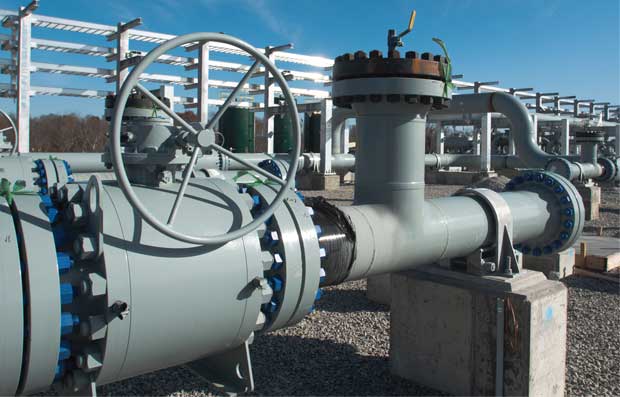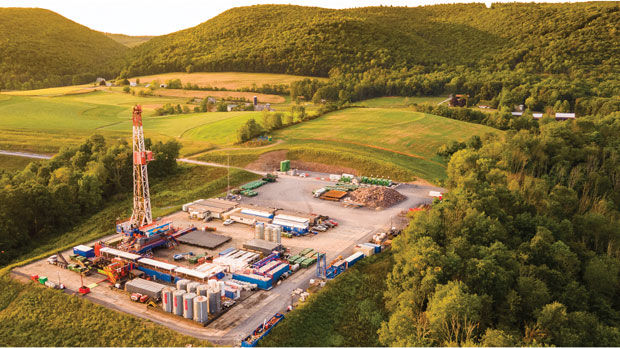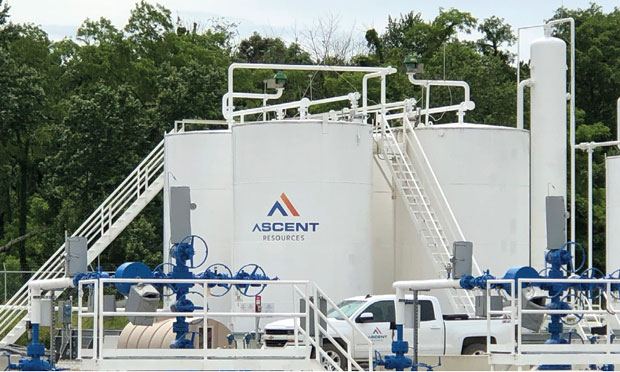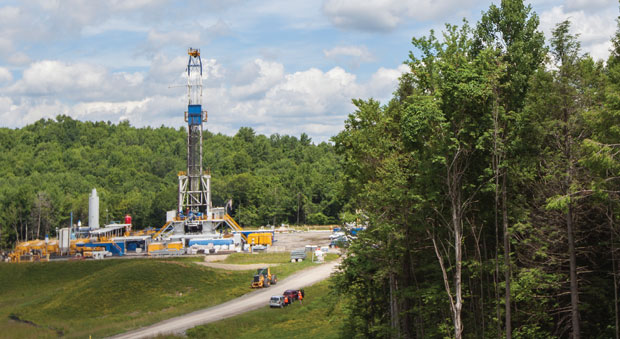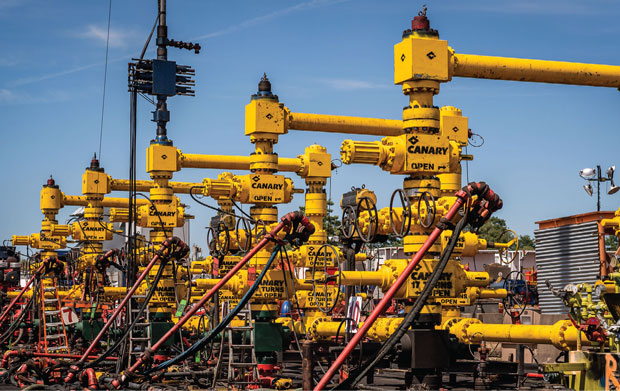
Northeast Natural Gas Dominoes Finally Falling In The Right Direction
By Danny Boyd
As of mid-October, the United States has built 10 natural gas-fired power plants in 2023. By the end of the year, the U.S. Energy Information Administration projects the number of new plants will grow to 16, with 20 more to follow across 2024 and 2025.
Add in growing U.S. natural gas exports, and Appalachian producers have ample cause to see stronger natural gas prices ahead. Even so, the basin’s operators are practicing the financial discipline and restraint that has become a hallmark of the modern oil and gas industry. According to EIA’s drilling productivity report for October, they are keeping natural gas production steady at around 36 billion cubic feet of gas a day.
To maintain production and ensure they can capitalize on future opportunities, the basin’s operators are perfecting proven drilling and completion techniques and experimenting with novel lateral geometries that promise to reduce costs and increase well productivity. At the same time, they are enhancing economies of scale through selective acquisitions.
CNX Resources Corp. is one of the operators that is driving efficiencies across its acreage position, which covers 1.1 million net acres. According to Chief Operating Officer Navneet Behl, one key to the company’s success is its penchant for combining upstream operations and midstream infrastructure.
Co-development reduces lease operating expenses and capital budget costs, Behl explains. The strategy enables the Canonsburg, Pa.-based company to optimize full-field planning, acreage utilization and stacked pay development by taking advantage of existing pads and midstream assets from initial delineation.
“For us, integrated midstream and upstream is a strategic business decision that gives us the competitive advantage of extracting value from our vast acreage position at the lowest cost possible,” Behl comments.
With upstream capital expenditures of $455 million-$475 million, CNX is drilling 34 wells this year to keep daily production around 1.6 billion cubic feet equivalent under a plan to guide development for the next two-three years, Behl says. He indicates the company’s goal is to maximize estimated ultimate recoveries at the lowest cost.
Rig automation is reducing costs, and the company is experimenting with air drilling using specially designed PDC bits to drill top sections faster. To guide surface software and help identify the best drilling designs, Behl says CNX is supplementing downhole logs with analysis modules in the bottomhole assembly and bit.
The resulting cost savings and extra insights are helping the company drill deeper and longer, Behl reports. In July, the drilling team reached total depth on CNX’s longest, deepest Utica well in southwestern Pennsylvania, with a true vertical depth of 13,765 feet and a lateral length beyond 15,000 feet, he illustrates. Two Marcellus laterals in the same area extended to 19,500 feet each.
Building midstream infrastructure has helped CNX Resources Corp. optimize its development schedules while cutting both capital expenditures and operating costs. Alongside improvements to drilling and completion techniques, the company says integrated development has helped it generate free cash flow for 15 consecutive quarters.
An electric hydraulic fracturing fleet set a record in summer for pumping hours, and hydraulic service units deployed by a key contractor have reduced incidences and improved plug drill outs, he shares.
By running sonic tools after the plugs have been removed, CNX is gathering data that is helping it refine its completion designs, Behl adds. In many areas, the company also draws on proprietary 3-D seismic.
Wells are performing at or above type curves in Southwest Pennsylvania and West Virginia, he reports. The completion designs average 240 feet per stage, with 575,000 pounds of sand and 8,000 barrels of treated water pumped at 100 barrels a minute.
According to Behl, CNX’s commitment to improving efficiencies across its operations has helped it generate free cash flow for 15 consecutive quarters. Instead of scouring the landscape for bolt-ons or acquisition targets, CNX’s leaders are buying back what they consider undervalued stock, Behl says.
“What we have realized, based on the internal valuation of our position, is we are more valuable, so we are acquiring ourselves everyday instead of acquiring someone else,” he says.
Steady Growth
A subsidiary of National Fuel Gas Co., Seneca Resources Co. is focusing mostly on developing the Utica in northern Pennsylvania this year. At the same time, it is looking for suitable acquisitions and bolt-ons to expand its 1.2 million net-acre position, says Seneca President Justin Loweth.
Such transactions have been a mainstay of the company’s growth, with Seneca prizing additions that include adjoining midstream infrastructure and firm transportation, he says. Three years ago, Loweth illustrates, the company acquired Shell’s Appalachian upstream and midstream assets, growing its proved, developed producing reserves by 25% and its land position by 40%.
In this year’s second quarter, Seneca purchased 30,000 net acres in northwest Tioga County, Pa., from Southwestern Energy Co. That came after adding other Tioga County assets earlier in the year. Two other recent bolt-ons expanded positions in Pennsylvania’s Potter and Lycoming counties in the eastern portion of Seneca’s position.
Seneca Resources Co. plans to drill 30 wells this year across its acreage in the Marcellus and Utica. To reduce costs and enable each pad to access more reserves, the company is leveraging more powerful rig motors to extend lateral lengths, which for some wells now exceed 13,000 feet.
Running two rigs and a frac crew, the 110-year-old company is developing 30 wells this year on an upstream budget of $550 million. Under the company’s mid-to-high guidance, this activity level should boost daily production to about 1.1 Bcfe, says Loweth, who also leads affiliated company National Fuel Gas Midstream Co.
Owning gathering, compression and dehydration assets provides major synergies and cost savings when returning to develop other benches from existing pads, he mentions.
“We can capture more resources from a pad and have fewer roads and pads to get that same resource recovered,” Loweth says. “There also is less gathering infrastructure to build and more throughput in existing pipes and compressor stations over time.”
Through long laterals and extended kickouts, Seneca can capture the resources in 6,000-8,000 acres from a single location, Loweth reports, noting that this significantly reduces costs. He says the company is using 5.5-inch drill pipe and more powerful rig motors to push outward. The company’s Utica laterals are as long as 13,000 feet, while the ones in the Marcellus range from around 7,000 feet to beyond 13,000 feet.
On completions, Seneca continues to improve limited entry perforation designs to ensure the best conductivity near the wellbore while continually analyzing other aspects of the design to balance intensity and costs, Loweth says. He points out that the company has transitioned entirely to electric frac fleets, enabling it to displace 90% of the diesel consumption in completions.
In Tioga County, the company’s Utica completions use 150-200 foot stages and pump 2,000-2,500 pounds of proppant and 55-65 barrels of fluid per lateral foot. Thanks in part to choke restrictions, each well is averaging 16 million-20 million cubic feet a day for several months, Loweth says.
Leveraging Optionality
Novel lateral configurations and completion designs are helping Ascent Resources ramp up oil and natural gas liquid drilling in the Ohio portion of the Utica and capitalize on higher prices for these products, says COO Keith Yankowsky. About 60% of Ascent’s liquids-rich wells are among the top 40 liquids producers in the play.
“It gives us a good bit of optionality to react to the pricing environment,” Yankowsky reflects. “We are behind that portion of the play and continue to be really pleased with the results.”
Since Ascent’s founding in 2014, about 10% of the company’s work has been in the liquids-rich windows on the western flank of the play. Now, those windows account for about a third of Ascent’s activity, which will include up to 75 total wells this year through an $800 million-$825 million drilling and completion program designed to keep daily production around 2.1 Bcfe.
With liquids-rich wells that are among the Utica’s top producers, Ascent Resources indicates it has the flexibility to capitalize on oil and natural gas liquids prices. The company adds that it is behind 24 of the Utica’s 40 strongest dry gas wells.
The Oklahoma City-based company also has 24 of the top 40 Ohio Utica dry gas wells, according to second quarter data from the Ohio Department of Natural Resources. These wells include two of the top five and seven of the top 10, Yankowsky points out.
To boost output across its position, Ascent continues to extend laterals. This year’s laterals are set to average 14,500 feet, up 1,000 feet from 2022, he says. He reports that the Gabriel 2H dry gas well’s horizontal extends 23,838 feet, making it the longest in Ohio.
To get more from lease configurations that restrict lateral lengths, Ascent is experimenting with unusual lateral designs. One such “U-zontal” lateral extends over 5,000 feet before circling back 1,000 feet away on the horizontal plane, providing 11,000 feet altogether.
“We think we can go another 3,000 to 4,000 feet longer,” Yankowsky envisions. “We have a handful of wells that we could do in the U-zontal style.”
While frac geometry becomes skewed when stimulation is not perpendicular to the stress as in typical laterals, Ascent includes four-five shorter stages in the curve and completes the segment with additional fluid, he details. Across the company’s asset base, stages normally range from 125 to 175 feet. Liquid wells are stimulated with 1,600-1,700 pounds a foot compared with 1,400-1,600 for dry gas wells.
Three wells on the Wampum pad in Guernsey County, Oh.—ground zero for Ascent’s liquids drilling—averaged 1,200 barrels of oil per day per well for three months. In the same area, the Jackelope pad wells produced 1,500 barrels of oil per day per well over the same period. Ascent choke manages wells to avoid excessive drawdown but has had liquids-rich wells test at 2,500 bbl/d, Yankowsky relates.
In addition to continuing to exploit the Utica formation, Ascent owns substantial Marcellus acreage rights that provide prospective inventory and optionality to test the formation at some point in the future. The company also remains open to the right acquisitions and bolt-ons, Yankowsky remarks.
High Standards
Chesapeake Energy Corp. keeps an eye out for potential acquisitions, but the company will only investigate opportunities that involve not only getting bigger but getting better, says COO Josh Viets.
“There needs to be real operational synergies associated with any transaction,” he says. “That’s why an acquisition we made last year with Chief Oil & Gas was so obviously beneficial, because it was a true bolt-on. We knew we could integrate Chief’s assets and gathering systems that we were already sharing and could create better financial outcomes by co-owning them. We continue to look at other acquisitions, but it’s about finding the right transaction at the right time that will deliver real synergies while clearly fitting within our merger and acquisition non-negotiables.”
In the meantime, the company innovates to increase lateral lengths and improve completion designs on a 465,000 net acre position in Pennsylvania that accounts for 54% of total company production. The remainder comes from the Haynesville Shale.
Armed with insights from analytical and machine learning software, Chesapeake drilled three of the five fastest Marcellus wells this year, Viets reports. For each well, the company drilled about 19,300 feet of wellbore in a little more than 10 days.
The company achieved that speed in part by tapping data analysts, geologists and geosteerers at its remote operating center in Oklahoma City, who use advanced software and visualization platforms to oversee the nine rigs working across the company. Systems determine whether wellbores are on target and inform drilling parameters such as weight on bit, rate of penetration and the pressure of the mud pumped down the drill string, Viets describes.
Across the Marcellus and Haynesville, Chesapeake Energy Corp. has drilled more than 22 million feet of lateral. The company says it is combining that experience with digital tools, including machine learning, to set internal drilling speed records in the Marcellus.
By drawing on more than a decade of experience in the Haynesville and Marcellus that includes drilling 22 million lateral feet, Chesapeake’s technical team has built models through ML that look ahead 100 feet to predict ROP and other factors in real time, Viets continues. He says another key application anticipates when BHAs will fail to help guide when a bit trip should be made. Deploying these tools has enabled the team to achieve the highest average footage per day in the Marcellus asset’s history during the most recent quarter.
Technology also has helped the company extend laterals 70% over the past five years, bringing the average upper Marcellus lateral to around 13,000 feet and the average lower Marcellus lateral to around 11,000 feet, Viets reports.
To gain additional efficiencies this year, Chesapeake is leveraging a hybrid development approach that involves drilling a segment of upper Marcellus and a segment of lower Marcellus from the same wellbore. The company estimates it has about 50 locations where this technique could prove advantageous. In October, the Appalachia team was on the cusp of bringing on six hybrid wells. One past hybrid had initial production of 29 MMcf/d, slightly below the company’s average IP of 30 MMcf/d.
“We can accelerate and high grade a lower Marcellus well by using a single wellbore to drill a section of upper Marcellus and then drop down and drill a section of lower Marcellus before coming back up and capturing additional upper Marcellus,” Viets explains. “That way, a 4,000-foot lateral becomes part of a 12,000-15,000-foot lateral, which enhances economics and reduces surface footprint.”
Redefining Efficiency
By employing a super-spec drilling rig and an electric frac fleet, Range Resources Corp. is finding ways to improve efficiency and performance as it develops its acreage position, which spans 70,000 net acres in northeastern Pennsylvania and 450,000 acres in a liquids-rich area in the state’s southwest corner.
Those efficiency gains are allowing the company to achieve its goals with fewer wells. “We still plan to turn to sale approximately 650,000 lateral feet this year. However, we will do so with 51 wells, 16% fewer than we planned at the start of the year,” says Chief Executive Officer Dennis Degner.
The company’s lateral lengths now average 13,000 feet, up from 10,000 last year. Degner says the extra length enables Range to deliver the same footage with 10 fewer wells, which equates to capital efficiency gains of $15-$20 a foot. In the third quarter, the company drilled two of the longest wells in its Marcellus program’s history, with both horizontals exceeding 21,000 feet and each wellbore’s total length stretching beyond five and half miles.
In the first half of 2023, Range Resources cut drilling times by 40% and completion times by 20%-25%, the company says. These efficiency gains include shortening the time between hydraulic fracturing stages from 15-30 minutes to 5-10.
Given Range’s long history in the area, maintaining production means returning to previous pads. In the third quarter, more than 75% of the 19 wells turned to sale were located on pads with existing production, Degner details. He points out that this approach allows the company to reduce costs by taking advantage of existing infrastructure.
The practice also highlights how much the company’s technical capabilities have grown, Degner reflects. Earlier this year, Range returned to one pad for the third time and drilled more lateral footage than in the two earlier trips combined, he illustrates. Also, three new wells on an existing pad in northeastern Pennsylvania resulted in 80% improvement in overall efficiency compared with initial development costs.
Overall drilling times have fallen 40% in the first half of the year, and completion times have dropped 20%-25%, Degner reports.
The electric frac fleet, which pumps about 1,500 pounds a lateral foot in the northeast and 2,000-2,500 pounds a foot in the liquids-rich southwest, is stimulating about 10 frac stages a day now, 20% more than last year. The crew set a record by completing 15 stages in 24 hours, Degner praises.
By using remote hydraulic valves to optimize the surface configuration, Range has reduced the time between frac stages from 15-30 minutes to 5-10, he adds.
“That does not sound like a big deal until you start to think about it translating across the more than 3,000 frac stages that we plan to do this year,” Degner comments. “The improvement is almost pulling a whole pad site of activity from the first quarter of 2024 into the fourth quarter of 2023.”
In the fourth quarter, Range expects to increase production 40 MMcf/d-60 MMcf/d from current production of about 2.12 Bcfe, Degner says.
With more than 3,000 locations in the core of the Marcellus that are profitable when gas prices are at or below $3.00, including 2,500 that deliver solid returns below $2.50, Range has no need to expand its position through mergers and acquisitions, Degner remarks. At projected drilling rates, the company has 30 years of running room.
According to Degner, Range is using its attractive acreage and operational know-how to keep its balance sheet strong. He says the company slashed net debt from more than $4 billion a few years ago to $1.6 billion as of early November, repurchased 400,000 shares over the past 18 months, and restarted a base dividend a little more than a year ago.
For other great articles about exploration, drilling, completions and production, subscribe to The American Oil & Gas Reporter and bookmark www.aogr.com.







